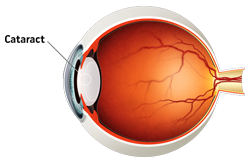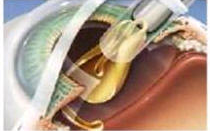This information was adapted from the National Eye Institute to help patients and their families search for general information

A cataract is a clouding of the lens in the eye that affects vision. Most cataracts are related to aging. Cataracts are very common in older people. By age 80, more than half of all Americans either have a cataract or have had cataract surgery. A cataract can occur in either or both eyes. It cannot spread from one eye to the other.
Yes. Although most cataracts are related to aging, there are other types of cataracts:


Normal Lens
Cataractous Lens
The term “age-related” is a little misleading. You don’t have to be a senior citizen to get this type of cataract. In fact, people can have an age-related cataract in their 40s and 50s. But during middle age, most cataracts are small and do not affect vision. It is after age 60 that most cataracts steal vision. The risk of cataracts increases as you get older. Other risk factors for cataracts include:
Certain diseases such as diabetes.
Personal behavior such as smoking and alcohol use.
The environment such as prolonged exposure to sunlight.
The most common symptoms of a cataract are:
These symptoms also can be a sign of other eye problems. If you have any of these symptoms, call to schedule an appointment with Southern Eye Associates.
The symptoms of early cataracts may be improved with new glasses, brighter lighting, antiglare sunglasses, or magnifying lenses. If these measures do not help, surgery is the only effective treatment. Surgery involves removing the cloudy lens and replacing it with an artificial lens.
Phacoemulsification clear cornea sutureless cataract surgery is the most common type of cataract surgery performed.

The lens is removed by ultrasound probe through a sub 3 mm incision.

A new lens implant is inserted into the capsular bag.

Self-sealing incision requires no stitches.
Yes, there are different types of lens implants. During a cataract evaluation, you and your doctor will discuss which lens will work best for you.
There is a basic cataract surgery and an advanced cataract surgery.
As with any surgery, cataract surgery poses risks, such as infection and bleeding. Before cataract surgery, your doctor may ask you to temporarily stop taking certain medications that increase the risk of bleeding during surgery. After surgery, you must keep your eye clean, wash your hands before touching your eye, and use the prescribed medications to help minimize the risk of infection. Serious infection can result in loss of vision.
Cataract removal is one of the most common operations performed in the United States. It also is one of the safest and most effective types of surgery. In about 90 percent of cases, people who have cataract surgery have better vision afterward.
Itching and mild discomfort are normal after cataract surgery. Some fluid discharge is also common. Your eye may be sensitive to light and touch. If you have discomfort, contact Southern Eye Associates and your doctor will suggest treatment. After one or two days, moderate discomfort should disappear.
For a few days after surgery, your doctor may ask you to use eye drops to help heal and decrease the risk of infection. Your doctor will instruct you about how to use eyedrops, how often to use them, and what effects they can have. You will need to wear an eye shield or eyeglasses to help protect your eye. Avoid rubbing or pressing on your eye.
When you are home, try not to bend from the waist to pick up objects on the floor. Do not lift any heavy objects. You can walk, climb stairs, and do light household chores. In most cases, healing will be complete within eight weeks. Your doctor will schedule exams to check on your progress.
Problems after surgery are rare, but they can occur. These problems can include infection, bleeding, inflammation (pain, redness, swelling), loss of vision, double vision, and high or low eye pressure. With prompt medical attention, these problems can usually be treated successfully. Sometimes the eye tissue that encloses the IOL becomes cloudy and may blur vision. This condition is called an after-cataract. An after-cataract can develop months or years after cataract surgery.
An after-cataract is treated with a laser. Your doctor uses a laser to make a tiny hole in the eye tissue behind the lens to let light pass through. This outpatient procedure is called a YAG laser capsulotomy. It is painless and rarely results in increased eye pressure or other eye problems. As a precaution, your doctor may give you eyedrops to lower your eye pressure before or after the procedure.